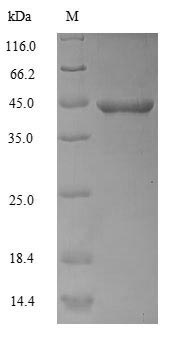The expression region of this recombinant Human ACTA1 covers amino acids 3-377. This ACTA1 protein is expected to have a theoretical molecular weight of 45.8 kDa. Expression of this ACTA1 protein is conducted in e.coli. The N-terminal 6xHis tag was fused into the coding gene segment of ACTA1, making it easier to detect and purify the ACTA1 recombinant protein in the later stages of expression and purification.
Actin, alpha skeletal muscle (ACTA1) is a widely expressed protein in muscle tissue, primarily involved in the study of muscle biology. In this field, ACTA1 plays a crucial role as it constitutes an essential component of the cell skeleton in muscle cells. Researchers focus on understanding the function of ACTA1 in muscle contraction and movement processes, as well as its role in maintaining muscle structure and stability. One of the most significant research directions is exploring the relationship between ACTA1 and muscle diseases, such as muscular dystrophy. Scientists also investigate the mechanisms of ACTA1 involvement in muscle regeneration and repair, which holds important implications for treating muscle injuries and diseases.






